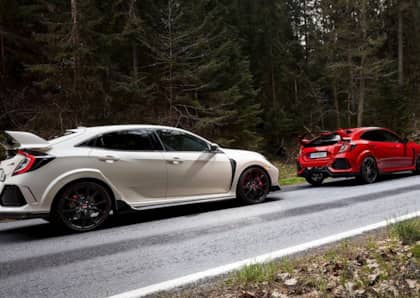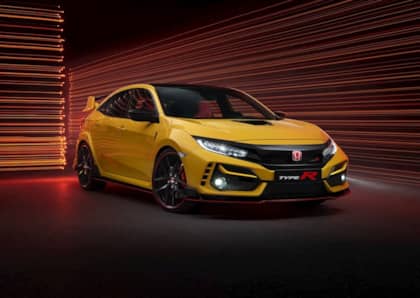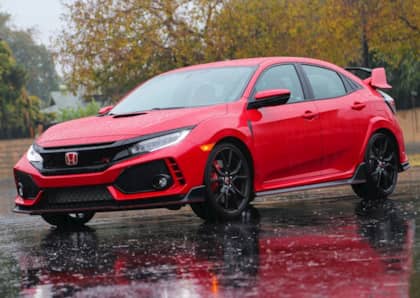Ranking Every Honda Civic Type R: Which One's Best?
America was largely left out of the Type R party for nearly two decades, for while the rest of the world had been enjoying the hottest version of the Civic since the 1990s, the Type R badge appeared exclusively on a brief run of the Acura Integra. Why the Japanese automaker chose to keep its high performance compact out of the United States for so many years is a matter of debate, but the fact remains that there is an entire universe of Type R performance out there waiting to be discovered by enthusiasts with a bigger-than-average import budget and an extra garage space or two.
In fact, there are six generations of the Honda Civic Type R plying roads and race tracks across the globe. How do they shake out when compared against each other? Check out our take on ranking the Type R.
6. 2007-2011 Honda Civic Type R FN2
The 8th-generation Civic Type R was a tale of two beasts: one, the FD2, was exclusive to Japan, and will be discussed later. The other was the FN2, a substantially different model that was offered everywhere else, primarily in Europe. This three-door hatchback sat on a completely different chassis that swapped a fully-independent rear suspension for a torsion-beam setup, one which was criticized for excess understeer and a rough ride.

It also retained the K20 four-cylinder engine from the car it replaced (the EP3), with only a few small improvements (redubbing the motor the K20KZ4), the 8,000 rpm redline delivered roughly 200hp and 142 lb-ft of torque. Even despite styling that has aged well, the FN2 simply couldn't keep up with the rest of the hot hatch market at the time of its release.
5. 2015-2016 Honda Civic Type R FK2
The FK2 Type R was a very big deal. This was the first turbocharged version of the car, thoroughly modernizing it after Honda fans had to sit on the sidelines for years after the release of the standard 9th generation Civic watching almost every other automaker introduce their own sporty hatchbacks. It featured just over 300hp and a startling 295 lb-ft of torque, which was close to 100 lb-ft more than the Type R had ever delivered in the past.

Built in Swindon, England, only a handful actually made it back to Japan, with the remainder sold primarily in Europe. The FK2 set the standard for the current version of the Type R, and while it's hobbled somewhat by a torsion bar rear suspension, its 5th place position is more indicative of its 'stop-gap' status before the current FK8 was released globally.
4. 2007-2011 Honda Civic Type R FD2
Compared to its European cousin, the FD2 walked a very different path. Sold as a four-door sedan, and featuring almost none of the gaudy aero that would come to define future versions of the car, it could be argued that the FD2 was a bit plain. Move past that and you're dealing with a stiff and lively platform featuring four-wheel independent suspension and some of the best-balanced front-wheel drive handling you're likely to experience.

Its K20A engine also offered 22 horsepower more than the contemporary FN2, and adding further insult to injury was the fact that it was considerably lighter thanks to its aluminum-intensive construction. Strangely, emissions issues caused the K20A to be replaced by the K20ZA for part of the car's final year of production in Japan.
3. 2001-2005 Honda Civic Type R EP3
The Type R EP3 was the first version of the car to be marketed outside of Japan—and for good reason, because it was built in the UK. It took the 'breadvan' looks of the Civic hatchback and married them with the high-revving (8,250 rpm) VTEC action of the K20A2 four-cylinder engine, which was good for 197hp.

European models featured a six-speed manual transmission (a first for the Type R) and big brakes, while Japanese editions gained a limited-slip differential, a stiffer suspension tune, and Recaro race seats. They also benefitted from the installation of the K20A, similarly-named but somewhat more powerful (212 hp) as compared to the Euro R engine. While the JDM edition was nearly a full second quicker to 60-mph, both cars were immense fun to drive, and stood in stark contrast to the turbocharged all-wheel drive models on offer at the time from Subaru, Mitsubishi and Nissan.
2. 2017-present Honda Civic Type R FK8
The current Honda Civic Type R fully embodies what the world has come to expect from a sport compact car, from its 306 horsepower turbocharged 2.0L engine all the way to its electronics-heavy drive experience and outstanding lap times. It's by far the quickest, and mightiest Civic to have ever graced a Honda showroom, and it's certainly an easy car to drive on a day-to-day basis (providing you don't mind the stares engendered by its flamboyant styling).

Why is it number two on this ranking, then? Modern technology giveth and taketh away, and in the case of the Type R its need for speed has come at the expense of the driving feel that was offered in past versions of the car. It's still an exceptional experience, but one that's representative of the new world of automotive design rather than building on the vehicle's heritage.
1. 1997-2000 Honda Civic Type R EK9
The EK9 was the Type R that started it all—not just the next two decades of compact performance for the Honda stalwart, but also a street scene that was looking to Japan for guidance on how to build hot front-wheel drive tuner rides. The car's 182 hp, 1.6L B16B four-cylinder engine soared to an unheard-of 8,200 rpm in order to access the full majesty of its VTEC variable-valve timing system, the small hatchback package guaranteed a low curb weight, and the parts interchange between not just the Civic but the Integra would help the performance scene grow by leaps and bounds throughout the decade.

It was a pint-size revolution, and while it might not have ever been sold in America, it made just as much impact on this side of the ocean as it did in its native Japan.
What's it like to live with the Honda Civic Type R on a day-to-day basis? Check out this one-year recap of daily driving the Type R.











